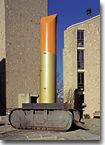| |
Comment on this article
The Lipstick
From Anti-War to “Morse Resource”
February 2000
by Judith Ann Schiff
Judith Ann Schiff is chief research archivist at the Yale University Library.
Student protests were in full swing on campus during the spring of 1969, and amidst almost daily demonstrations, a monumental sculpture mysteriously appeared on the Beinecke Plaza. The enigmatic artwork—a gigantic “lipstick” that stood 24 feet tall and appeared to be mounted on the body of a tank—was the creation of Pop Art sculptor Claes Oldenburg ’50. Its presence in front of the World War I Alumni War Memorial inspired some and infuriated others, and it quickly became a focal point for antiwar demonstrations and student rebellion.
The appearance of Lipstick (Ascending) on Caterpillar Tracks, as the piece was formally titled, may have taken Yale by surprise, but plans for the sculpture had been under way since the previous fall. The project came to light when Jonathan Price ’68DFA interviewed Oldenburg for a profile for this magazine. As part of the article, the editors asked the sculptor to prepare a design for a University monument that would then be published in the Yale Alumni Magazine.
Oldenburg, who was known for his soft sculptures, had already proposed “colossal monuments” for other venues, such as a giant vacuum cleaner for the Battery in New York City and a windshield wiper for Chicago’ Grant Park. At the time, however, both remained unbuilt.
The Yale Alumni Magazine project fell through, but that fall, Stuart Wrede ’65, ’70MArch, a graduate student in architecture, pushed forward with his own plan for an Oldenburg monument. It was quickly adopted by the editors of the Yale architectural journal Perspecta, which started to raise funds for the actual construction of such a monument. Students, faculty, and alumni contributed the cost of the materials, and Oldenburg, who charged no fee for his work, organized the group under the name of the Colossal Keepsake Corporation of Connecticut.
The entire project was kept secret from the Yale authorities. Oldenburg inspected various campus sites and decided on Beinecke Plaza. The form of the sculpture was suggested by a long orange balloon he saw fluttering from a car parked near the site. On May 15, the first day of final exams, the clandestine plan was revealed when pieces of the 3,500-pound artwork were trucked onto the quadrangle. A large crowd gathered to see the construction of a gold-colored tube of orange lipstick mounted on a largely steel base that was equipped with rust-colored caterpillar treads. It was Oldenburg’s first monumental public sculpture to be completed.
The Colossal Keepsake Corporation gave the deed of gift to Yale, but no official action to accept it was taken by the administration. Professor Vincent Scully saw humor in Lipstick, describing it as “the Beinecke’s natural complement on the dressing table.” When the students returned to the campus in the fall of 1969, women were admitted to the college for the first time, leading some to view the sculpture as a female symbol of coeducation. Others interpreted the shaft as a phallic symbol; this was particularly true of the Class of 1970, which stated in their class book in more explicit terms that can be reprinted here that the sculpture was a way of plainly “saying to all the King’s men. Here is our culture.”
Month by month, campus unrest mounted. There were moratoriums to end the war in Vietnam, a student strike at the Law School, the SDS occupation of Wright Hall, and demonstrations in support of the Black Panthers. The tanklike base of Lipstick served as a rally platform, and the monument was soon covered with graffiti and posters. The sculpture did not hold up well to the attention and the elements. Initially, the lipstick tip was made of inflatable vinyl, but after being pumped up, it soon deflated and was later replaced by rigid plastic. By March of 1970, the wooden tracks had rotted from exposure and Oldenburg removed the sculpture to the factory in North Haven where it was made.
Within a year, a group of art professors and historians organized to bring Lipstick back to Yale as an important work of American art. Vincent Scully, then master of Morse College, enlisted the support of the students, and offered the college courtyard as a permanent installation site. Money was raised to restore the sculpture and construct new steel tracks. In the fall of 1974 Lipstick was officially accepted by the Art Gallery and placed on indefinite loan to Morse College.
After a quarter of a century, how do today’s Morse residents view Oldenburg’s inspiration? According to the college website, the Pop Art sculpture is deemed a “Morse resource.” “Morse without Lipstick is like Yale without Harkness (minus the bells),” say the students.  |
|


